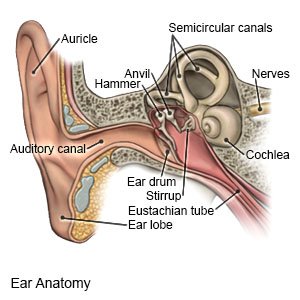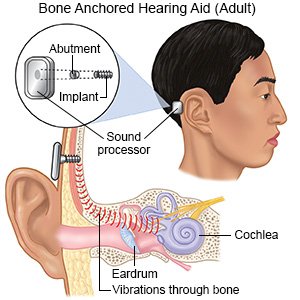Bone Anchored Hearing Aid Surgery
Medically reviewed by Drugs.com. Last updated on Aug 4, 2025.
AMBULATORY CARE:
Bone anchored hearing aid (BAHA) surgery
is used to place a BAHA device in your ear. The device transmits sound through bone to your inner ear. A BAHA is used in people with hearing loss or who cannot use traditional, in-ear hearing aids.
 |
The 2 parts of a BAHA:
- The sound processer device is worn behind your ear. It has a microphone that receives sound vibrations. These vibrations are sent to the implant called the receiver.
- The receiver is implanted under the skin, in the bone behind your ear. The vibrations from the sound processor transmit through the implant to your inner ear. This causes the nerve fibers in your ear to activate and helps you hear.
 |
How to prepare for BAHA surgery:
- Your healthcare provider will tell you how to prepare for surgery. Your provider may tell you not to eat or drink anything after midnight on the day of surgery. Arrange to have someone drive you home after your surgery.
- Tell your provider about all your current medicines. Your provider will tell you which medicines to take or not take on the day of surgery.
- Tell your provider about any allergies you have, including to anesthesia or medicines. You may be given an antibiotic to prevent a bacterial infection.
What will happen during BAHA surgery:
- You may be given general anesthesia to keep you asleep and free from pain during surgery. You may instead be given local anesthesia to numb the surgery area. With local anesthesia, you may still feel pressure or pushing during surgery, but you should not feel any pain.
- Your surgeon will make a circular incision behind and above your ear. Your surgeon will make a small hole in the middle of the circle and insert a titanium implant. The incision will be covered with your skin and closed with stitches. A bandage piece, called a cover screw or healing cap, will be placed over the area.
What to expect after BAHA surgery:
- The stitches will be removed 7 to 14 days after surgery. The BAHA will not work right away. Your incision should heal in 6 to 8 weeks. It may take 3 to 6 months for the bone to grow around the implant and secure it. The device is not activated until this is complete.
- After this period of time, the cover screw is removed. The external sound processor device is attached to the implant.
Risks of BAHA surgery:
You may develop an infection. You may develop a large scar. The skin attached with stitches may not get enough blood supply. This can cause tissue death. Your BAHA may not be in the right place, or it could stop working. You may need another surgery to fix it.
Seek care immediately if:
- Clear fluid leaks from your ear or nose.
- Your face is numb, or you cannot move parts of your face.
- You have a severe headache.
- Your neck feels painful or stiff.
Call your surgeon or doctor if:
- You have a fever, chills, and feel weak and achy.
- Your surgery area is red, swollen, or draining pus.
- You feel dizzy or have nausea and are vomiting.
- You feel more sleepy than usual.
- You have questions or concerns about your condition or care.
Care for the surgery area:
Carefully wash the area gently with soap and water. Pat the area dry gently.
Follow up with your surgeon or doctor as directed:
You may need to return to have your stitches removed. You may go to a specialist to learn how to use your BAHA and how to care for it. You may need regular checkups to make sure your BAHA works properly. Write down your questions so you remember to ask them during your visits.
© Copyright Merative 2025 Information is for End User's use only and may not be sold, redistributed or otherwise used for commercial purposes.
The above information is an educational aid only. It is not intended as medical advice for individual conditions or treatments. Talk to your doctor, nurse or pharmacist before following any medical regimen to see if it is safe and effective for you.
Further information
Always consult your healthcare provider to ensure the information displayed on this page applies to your personal circumstances.
